Arm Announces Neoverse N1 & E1 Platforms & CPUs: Enabling A Huge Jump In Infrastructure Performance
by Andrei Frumusanu on February 20, 2019 9:00 AM ESTFirst N1 Silicon: Enabling the Ecosystem with SDPs
A little known fact about Arm is that the company designs its own silicon test platform – actually deploying them on development board to enable validation and software development on hardware that Arm and developers have full control of. The latest generation was the Juno platform, which in its first revision started off with a Cortex A57 and served as the fundamental silicon testbed for ARMv8 software.
Ever since Arm started the programme in 2014, Arm has shipped over 1400 boards both internally and to its partners. The amount of chips we’re talking about here sounds paltry, however we have to keep in mind we’re talking about very limited shuttle runs on MPW (multi-project wafers) where Arm shares wafer space with numerous other companies.
For today’s announcement, Arm had the pleasure to reveal that it received back the first working Neoverse N1 silicon back in December – with the chips meant to be integrated into the new Neoverse System Development Platform (SDP).
The N1 SDP represents major step for Arm as it not only is the first silicon to come back with the N1 CPU, but also is Arm’s first own 7nm silicon. The platform represents a major proof of concept of the IP, as well as interoperability with third-party IP, employing a lot of the peripheral IP such as PCIe and DDR PHY supplied by Cadence.
The actual hardware is a limited implementation of an N1 SoC – we find a 4-core N1 CPU with 1MB L2 configuration in the form of 2xMP2 connected to a CMN-600 with an 8MB SLC setup.
The board includes a CCIX compatible PCIe 4.0 x16 slot which serves the crucial role of enabling development and demonstrating cache-coherent integration with CCIX hardware such as Xilinx’s FPGA.
The N1 SoC actually doesn’t contain dedicated I/O IP, rather Arm implements all connectivity via a dedicated FPGA which serves as the I/O hub, supporting various connectivity options such as Ethernet, USB, SATA and so on.
Naturally the big selling point of the SDP is its completely open-source firmware stack from not only the OS drivers, but more importantly the SCP and MCP firmware.
An important new feature that is first employed by the new N1 CPU is the introduction of statistical profiling extensions (SPE). The new extension enables the first ever self-hosted profiling capability in an Arm CPU – meaning we don’t require a separate CPU or system having to read out microarchitectural counters. Instead the new SPE can be configured to directly write this information into memory. The tool is extremely useful for tracing code and analysing core behaviour, identifying possible performance issues and further squeezing out the maximum performance out of a platform, something Arm is taking very seriously if it wants to succeed and gain adoption in HPC.
Finally, the N1 SDP will be available later this quarter – although don’t expect the board to be easily attainable for the average user.


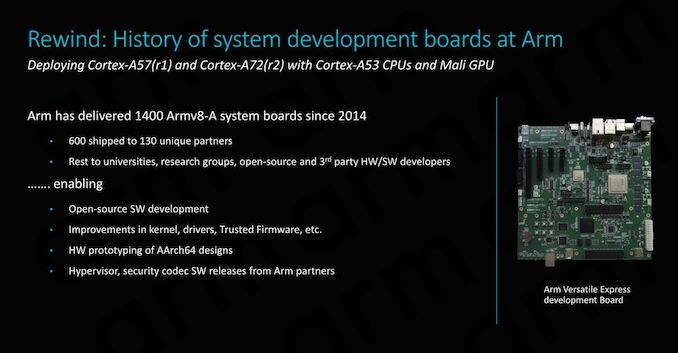
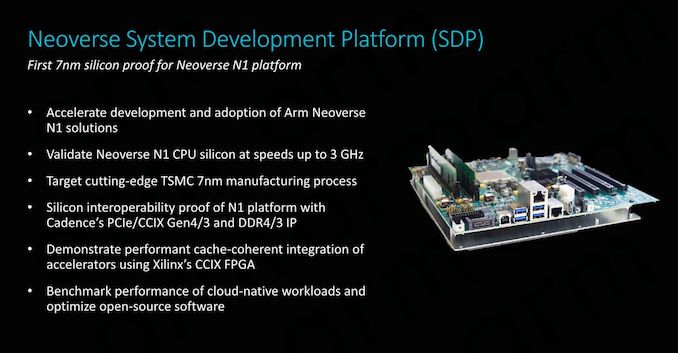
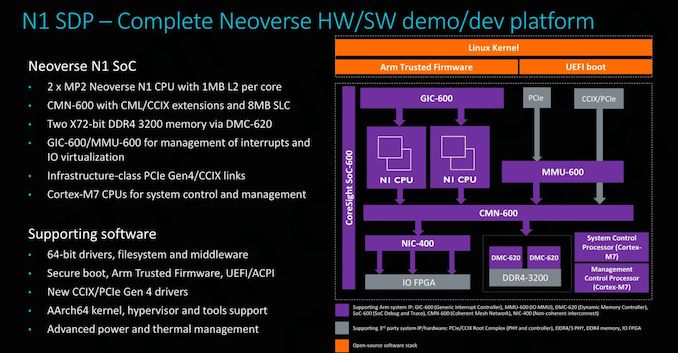
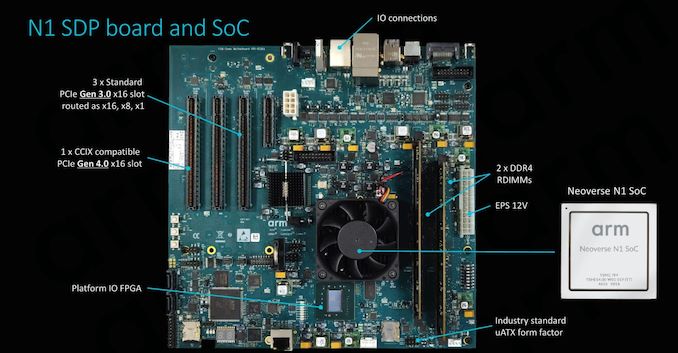

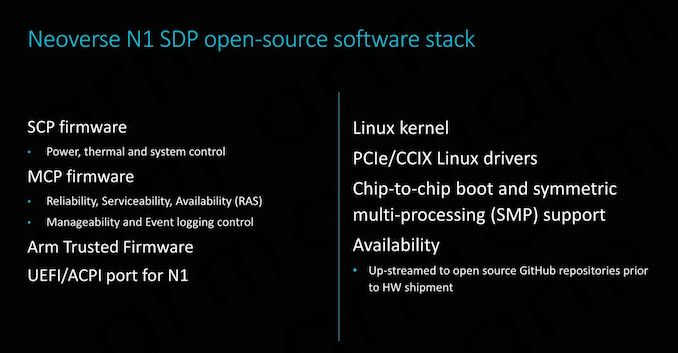

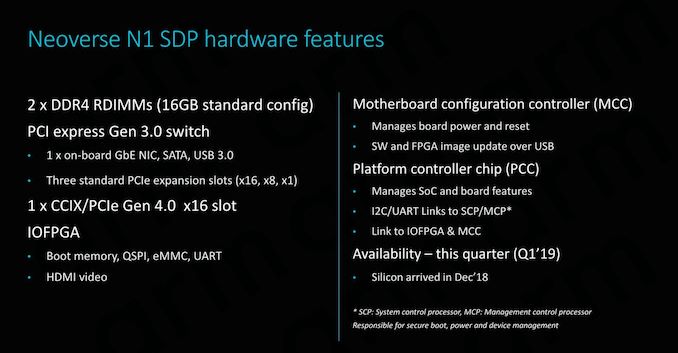








101 Comments
View All Comments
blu42 - Thursday, February 21, 2019 - link
Yep. While ISA may not matter as an aggregate over the set of all tasks, ISAs matter very much when it comes to the performance of any individual task, just the same way as ASICs matter versus gen-purpose CPUs for any given task. One can think of ASICs as an extreme-case specialization of gen-purpose ISAs.Meteor2 - Wednesday, February 20, 2019 - link
Indeed, and reality is that all architectures are converging in terms of performance. It’s just a question of how much money any given manufacturer wants to invest. Intel cut R&D and the results are plain. AMD invested wisely. What Apple has achieved with the ARM ISA is phenomenal. Goodness knows what they could do if they turned their attention away from mobile but goodness knows how much it cost, too.Vitor - Wednesday, February 20, 2019 - link
Although the article is about servers and such, I can't help thinking that in less than a decade RISC CPUs can overtake the deskop/notebook market.And, corretct if I'm wrong, RISC is inherently more efficient than X86 derivates.
SarahKerrigan - Wednesday, February 20, 2019 - link
The evidence for "inherently more efficient" is pretty shaky, although I'd venture that validation of ARM cores is considerably simpler than validation of x86.That being said, ARM has been delivering rapidly and consistently on uarch, and Intel has not.
hMunster - Wednesday, February 20, 2019 - link
ARM is playing catch-up to Intel which got to the point of "no more low hanging fruit" much earlier.Wilco1 - Wednesday, February 20, 2019 - link
Well as an example Intel was unable to design competitive SoCs for the mobile market despite having a process advantage, investing $10+ Billion and even paying various companies to use their chips - "contra-revenue". There is no doubt the complexity of x86 translates into a significant overhead in design and verification, area, power and (at the low end) performance.hMunster - Wednesday, February 20, 2019 - link
The RISC vs. CISC debate does not really matter much anymore.HStewart - Wednesday, February 20, 2019 - link
A lot of this is because CISC process can now handle multiple microinstructions per clock cycle taking advantage of RISC smaller instruction away.But software compatibility is the major concern with this and Microsoft has many failed attempts to try to change this dependency.
FunBunny2 - Wednesday, February 20, 2019 - link
"A lot of this is because CISC process can now handle multiple microinstructions per clock cycle taking advantage of RISC smaller instruction away."that's a testable assertion. not by me, however. the execution of multiple microinstructions by CISC ISA machines doesn't mean, ceteris paribus, that the overlying CISC instruction runs as efficiently as a native RISC instruction; it just must run through the microinstructions. to the extent that CISC ISAs are really executed as some RISC machine on the silicon, that doesn't mean, apples to apples, that said CISC machine executes as efficiently as a native RISC machine. (native RISC does make headaches for the compiler writer, no doubt.) I'd wager that the real reason for RISC microarch was the desire to continue with X86 object code with a bit more performance back when the transistor budget began expanding, but not enough to build the entire ISA in silicon. and to keep the compiler writer from having to continually update as the real ISA (RISC) keeps changing. die shots of current cpu show that the 'core' is a diminishing percent of the real estate.
the still unanswered question: why did Intel/AMD not use the exploding transistor budget to execute the entire instruction set in hardware, but to create these behind-the-scenes RISC machines?
wumpus - Wednesday, February 20, 2019 - link
From memory, Dec was able to make VAX four times faster by pipelining the microcode from VAX instructions compared to "executing the VAX instruction all at once faster". VAX was about the CISCisest CISC that ever CISCed (and sold successfully. I think Intel's BiiN was worse).Dec also made Alpha, which even the first iteration was another 4 times faster than the "pipelined microcode" VAX.
And this was all single issue. Don't even think of trying to issue multiple "full CISC" instructions at once.